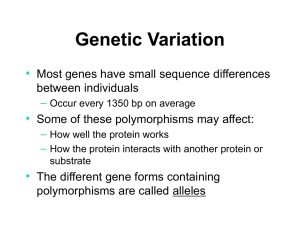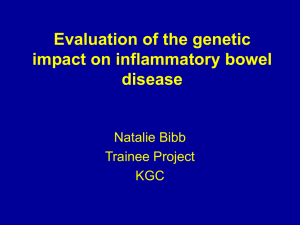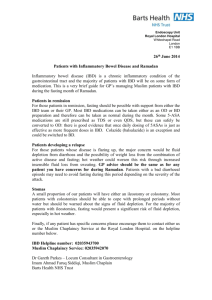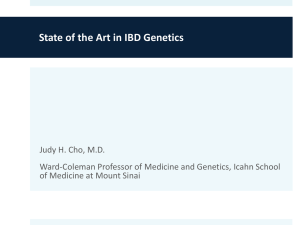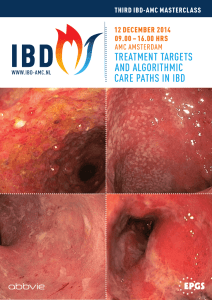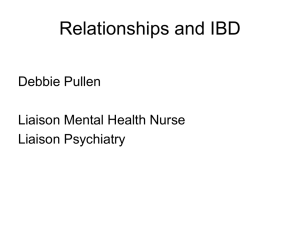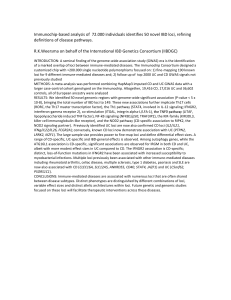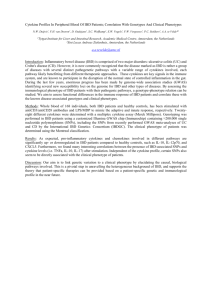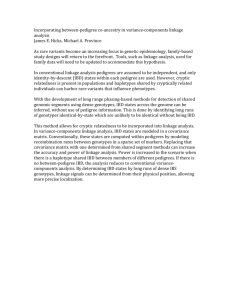Detecting Allelic Imbalance in Inflammatory Bowel Disease
advertisement
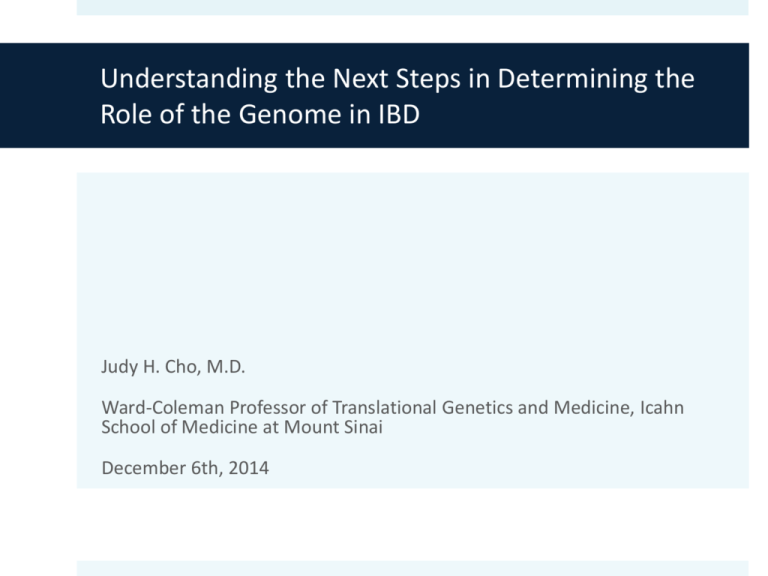
Understanding the Next Steps in Determining the Role of the Genome in IBD Judy H. Cho, M.D. Ward-Coleman Professor of Translational Genetics and Medicine, Icahn School of Medicine at Mount Sinai December 6th, 2014 Questions What naturally occurring genetic polymorphisms are associated with IBD? What naturally occurring genetic polymorphisms are associated with IBD? Assessment Value: molecular insight profoundly shaped the landscape of IBD research What’s worked and what hasn’t Family-based: linkage NOD2. Otherwise, family-based studies have not worked—re-vist with microbiome-based studies & genetic counseling Case-control: 163 loci and counting Surprises & advances Magnitude of sample sizes required unexpected: NOD2 (Nature 2001) involved 416 CD samples - > 30,000 cases Number of significant loci larger than expected: 163 and counting Advances: autophagy, IL-23 pathway, M1-M2 macrophage subsets Challenges: long journey from genes biology drug targeting new drugs Questions What naturally occurring genetic polymorphisms are associated with IBD? What are the functional consequences of IBDassociated polymorphisms? What are the functional consequences of IBDassociated polymorphisms? Altered cytokine responses to microbial stimulation : NOD2, XIAP (direct); many indirect effects Genotype-dependent variable bacterial clearance: autophagy, NADPH oxidase Direct ex vivo analyses IL23R and Th17/Tc17 cells (Sarin et al., PNAS 2011) NOD2 & Paneth cell morphologies (Van Dussen Gastroenterology 2014) Altered regulation of gene expression What are the functional consequences of IBDassociated polymorphisms? Altered cytokine responses to microbial stimulation : NOD2, XIAP Genotype-dependent variable bacterial clearance: autophagy, NADPH oxidase Direct ex vivo analyses IL23R and Th17/Tc17 cells (Sarin et al., PNAS 2011) NOD2 & Paneth cell morphologies (Van Dussen Gastroenterology 2014) Altered regulation of gene expression Expression quantitative trait loci (eQTL) mapping mRNA expression as a continous trait Heritable Mappable to specific SNPs Cell lines, tissues and contextspecificity Presently defined eQTLs likely only a subset of genuine eQTLs LPS- & IFNg stimulated monocytes define more eQTLs 80% of transcripts with eQTLs Morley, et al., Nature 2004; 430: 743 Dixon, et al., Nature Genetics 3007; 39: 1202 Fairfax et al., Science 2014 Fine-mapping in autoimmunity Fine-mapped autoimmune loci 90% are non-coding 60% map to immune enhancers Histone marks: greatest enrichment seen for H3K27ac—active/stimulated enhancers Disease-associated SNPs in enhancers are near, but not within consensus transcription factor binding sites Farh et al., Nature 2014 Enrichment of CD loci genes in open chromatin regions of Th17 cells, but not monocytes Category (N) Th17 cell DNase I HS site Monocyte DNase I HS site Yes (14,267) No (10,195) Yes (16,317) No (8145) CD loci non CD loci log OR (#gene=1328) (#gene=23,134) (95% CI) 945 (71.2%) 13,322 (57.6%) 0.6 (0.48, 0.72) 383 (28.8%) 9812 (42.4%) 862 (64.9%) 15,455 (66.8%) -0.08 466 (35.1%) 7679 (33.2%) (-0.20, 0.032) p-value 5.90E-22 Apples to oranges: Th17 cells vs. monocytes Pending: tissue-specific enhancer landscape of organ- and context-specific tissue macrophages 0.15 From co-expression to (genetic) causal networks aka NRAMP NOD2 SLC11A1 IL10 VDR HCK CARD9 DOK3 Highly correlated RNA expression between NOD2, IL10 & HCK (hematopoietic cell kinase) HCK: key for differentiation of M2 macrophages LGALS9 Gene in IBDassociated locus Cis eQTL in HCK: variable HCK expression is driving variable NOD2 & IL10 expression Eric Schadt Jostins et al, Nature 2012 Primary value of direct ex-vivo analyses: pathogenic & protective cells Defining innate cell hierarchies by high-dimensional Cytof analysis Uninflamed CD14 HLADR BDCA3 Inflamed High dimensional analyses needs to be matched to deep clinical information Basic science questions Cellular plasticity and diffentiation DNA-RNA-protein What are the functional consequences of IBDassociated polymorphisms? Altered cytokine responses to microbial stimulation : NOD2, XIAP Genotype-dependent variable bacterial clearance: autophagy, NADPH oxidase Direct ex vivo analyses IL23R and Th17/Tc17 cells (Sarin et al., PNAS 2011) NOD2 & Paneth cell morphologies (Van Dussen Gastroenterology 2014) Altered regulation of gene expression Acceleration of in vitro & in vivo studies with CRISPR/CAS9 technologies: refined genetic & molecular definition will improve modeling Questions What naturally occurring genetic polymorphisms are associated with IBD? What are the functional consequences of IBDassociated polymorphisms? Why do Ashkenazi Jewish populations have a higher IBD prevalence? Rare variants Common variants Rare variants are “less rare” in AJs AJ Flemish 128 whole genome sequenced in AJs Rare variants are “less rare” in AJs compared to Flemish Profound population bottleneck in AJs Derived allele frequency Carmi et al., Nature Commun 2014 Ashkenazi Jews with a higher composite burden score than non-Jewish European ancestry IBD Genetic Burden Score Developing integrative models of common variant risk? Striking overlap between IBD & mycobacterial susceptibility NOD2 RIPK2 **TNFSF15 163 IBD loci LRRK2 IL23R 7/9 6/7 C13orf31 7 multigenic leprosy GWAS loci IL12B STAT1 IRF8 TYK2 STAT3 IFNGR2 IFNGR1 9 single gene mycobacterial (Tb) genes Anti-TNF treatment of IBD associated with re-activation of latent mycobacterial disease NEJM 2001; 345: 1098 Epidemiologic support for the Jewish-Tb hypothesis NYC, 6 years before 1890 per 100,000 Deaths from tuberculosis, London 1894-1900 Population Deaths per 100,000 Mussulman Arabs 1130 Europeans 513 Jews 75 Jacobs J. The Jewish Encyclopedia; a guide to its contents, an aid to its use. New York, London: Funk & Wagnalls company; 1906. Polygenic adaptation: positive selection at scores to hundreds of genes that confer selective advantage Population NY Brooklyn African-American 774.21 531.35 Ireland 645.73 452.79 Bohemia 499.13 347.22 Russia and Poland 98.21 (mostly Jews) 76.72 Scotland 384.12 269.24 Scandinavia 357.00 218.92 Canada 352.32 266.27 Germany 328.80 295.61 France 394.98 252.82 England and Wales 322.50 233.78 Italy 233.85 123.00 United States (White) 205.14 180.79 Hungary (mostly Jews) 155.05 120.77 Questions What naturally occurring genetic polymorphisms are associated with IBD? What are the functional consequences of IBDassociated polymorphisms? Why do Ashkenazi Jewish populations have a higher IBD prevalence? What factors are genetic and what are nongenetic/stochastic/developmental? Better modeling of genetic contributions More frequent modeling of environmental/stochastic factors Systematic analysis of rare variants via enteroids Biopsy Add growth factors Stem cells Stem cells > Ascertaining by genotypes > CRISPR-CAS9 Bank of rare variants broadly amenable for study IgA-coating enriches for colitogenic bacteria Stool-based collections: IgA enrichment may identify functionally important bacteria—reducing microbial complexity Frequent sampling Palm et al., Cell 2014 Questions What naturally occurring genetic polymorphisms are associated with IBD? What are the functional consequences of IBDassociated polymorphisms? Why do Ashkenazi Jewish populations have a higher IBD prevalence? What factors are genetic and what are nongenetic/stochastic/developmental? UC: limited vs. extensive disease CD: ileal post-op—modeling first steps of disease recurrence Age-dependent effects: disease severity & age of onset Acknowledgements Cho lab NIDDK IBD Genetics Consortium Steve Brant Richard Duerr Dermot McGovern John Rioux Mark Silverberg Mark Daly Phil Schumm Thad Stappenbeck-Wash U: enteroids Yale University Clara Abraham Richard Flavell RISK Pediatric Consortium Subra Kugathasan Ted Denson Ken Hui Monica Bowen Kyle Gettler Kaida Ning Nai-Yun Hsu Felix Chuang Yashoda Sharma Mount Sinai collaborators Inga Peter Eric Schadt Miriam Merad Bruce Sands Jean-Fred Colombel

